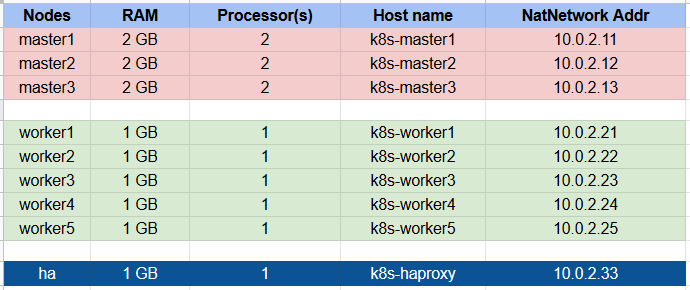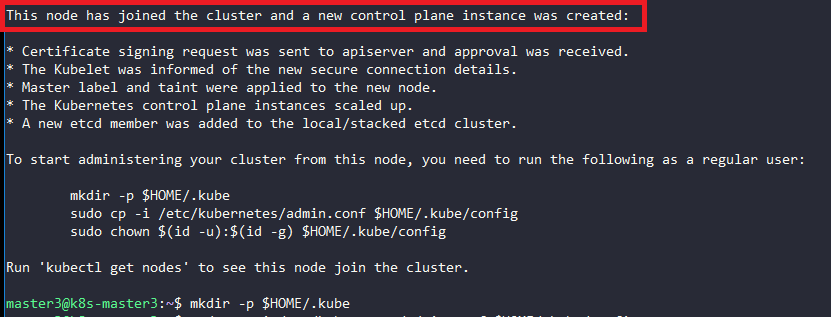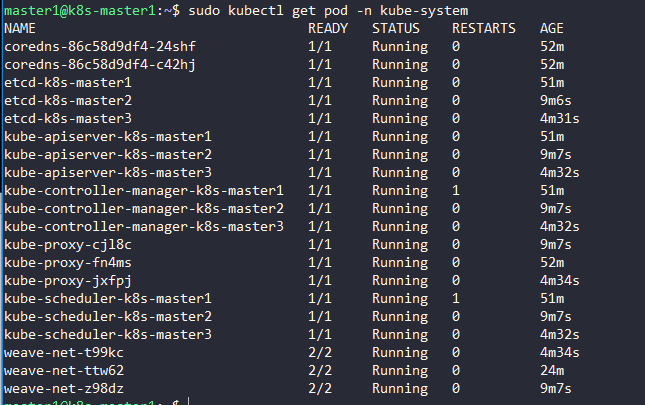Kubernetes High Availability
1. Preparation
1.1. Installing bare-metal server and creating necessary VMs
The bare-metal server runs Ubuntu Server 16.04 and there are 9 Virtual Machines (VMs) will be installed on it. Both of the VMs also run Ubuntu Server 16.04.
- 3 master nodes
- 5 worker nodes
- 1 HAproxy load balancer
The configurations of nodes
1.2. Installing docker kubelet kubeadm kubectl kubernetes-cni on master nodes and worker nodes
Adding kubernetes repo:
$ curl -s https://packages.cloud.google.com/apt/doc/apt-key.gpg | apt-key add -
$ echo "deb http://apt.kubernetes.io/ kubernetes-xenial main" >> ~/kubernetes.list
$ sudo mv ~/kubernetes.list /etc/apt/sources.list.d
$ sudo apt-get update
$ sudo apt-get install -y docker.io kubelet kubeadm kubectl kubernetes-cni --allow-unauthenticated
Configuring proxy for apt
$ sudo vim /etc/apt/apt.conf
Acquire::http::proxy "http://[Proxy_Server]:[Proxy_Port]/";
Acquire::HTTP::proxy "http://[Proxy_Server]:[Proxy_Port]/";
Configuring proxy for docker
$ sudo mkdir -p /etc/systemd/system/docker.service.d
$ sudo vim /etc/systemd/system/docker.service.d/http-proxy.conf
[Service]
Environment="HTTP_PROXY=http://[Proxy_Server]:[Proxy_Port]/"
1.3. Installing HAproxy load balancer
Installing haproxy on ha machine (IP: 10.0.2.33)
$ sudo apt-get install haproxy
Configuring HAProxy to load balance the traffic between 3 master nodes.
$ sudo vim /etc/haproxy/haproxy.cfg
Modifying content of file haproxy.cfg as below:
global
log /dev/log local0
log /dev/log local1 notice
chroot /var/lib/haproxy
...
...
frontend kubernetes
bind 10.0.2.33:6443
option tcplog
mode tcp
default_backend kubernetes-master-nodes
backend kubernetes-master-nodes
mode tcp
balance roundrobin
option tcp-check
server k8s-master1 10.0.2.11:6443 check fall 3 rise 2
server k8s-master2 10.0.2.12:6443 check fall 3 rise 2
server k8s-master3 10.0.2.13:6443 check fall 3 rise 2
- The health check for an apiserver is a TCP check on the port which the kube-apiserver listen on. The default value: 6443
- In frontend section: bind to
ha machine IP address (10.0.2.33)- In backend section: Notice the hostname and IP address of 3 master nodes
Restart the HAproxy
$ sudo systemctl restart haproxy.service
2. Creating HA cluster with kubeadm
2.1. Steps for the 1st master node
On the master node master1 (IP: 10.0.2.11), create a configuration file kubeadm-config.yaml:
apiVersion: kubeadm.k8s.io/v1beta1
kind: ClusterConfiguration
kubernetesVersion: stable
apiServer:
certSANs:
- "10.0.2.33"
controlPlaneEndpoint: "10.0.2.33:6443"
- The
kubernetesVersion is the Kubernetes version which is using. This configuration uses stable - The
controlPlaneEndpoint is the ha machine’s IP address with port 6443 Deploying node master1:
$ sudo kubeadm init --config=kubeadm-config.yaml
The terminal will print something like this:
...
You can now join any number of machines by running the following on each node
as root:
kubeadm join 10.0.2.33:6443 --token 7ju4yg.5x2xaj96xqx18qwq --discovery-token-ca-cert-hash sha256:4d7c5ef142e4faca3573984119df92a1a188115723f1e81dbb27eeb039cac1e0
master nodes to the cluster.Applying the Weave CNI plugin:
$ sudo kubectl apply -f "https://cloud.weave.works/k8s/net?k8s-version=$(kubectl version | base64 | tr -d '\n')"
Verifying that the pods of the components are ready:
$ sudo kubectl get pod -n kube-system -w
NAME READY STATUS RESTARTS AGE
coredns-86c58d9df4-8vcxh 1/1 Running 0 4h38m
coredns-86c58d9df4-ts6x2 1/1 Running 0 4h38m
etcd-k8s-master1 1/1 Running 0 4h37m
kube-apiserver-k8s-master1 1/1 Running 0 4h37m
kube-controller-manager-k8s-master1 1/1 Running 0 4h37m
kube-proxy-dhnjk 1/1 Running 0 4h38m
kube-scheduler-k8s-master1 1/1 Running 0 4h37m
weave-net-cqb88 2/2 Running 0 4h22m
Copy the certificate files from the 1st master node to the master2 and master3
$ vim copy.sh
USER=root
MASTER_NODE_IPS="10.0.2.12 10.0.2.13"
for host in ${MASTER_NODE_IPS}; do
scp /etc/kubernetes/pki/ca.crt "${USER}"@$host:
scp /etc/kubernetes/pki/ca.key "${USER}"@$host:
scp /etc/kubernetes/pki/sa.key "${USER}"@$host:
scp /etc/kubernetes/pki/sa.pub "${USER}"@$host:
scp /etc/kubernetes/pki/front-proxy-ca.crt "${USER}"@$host:
scp /etc/kubernetes/pki/front-proxy-ca.key "${USER}"@$host:
scp /etc/kubernetes/pki/etcd/ca.crt "${USER}"@$host:etcd-ca.crt
scp /etc/kubernetes/pki/etcd/ca.key "${USER}"@$host:etcd-ca.key
scp /etc/kubernetes/admin.conf "${USER}"@$host:
done
root of 1st master node.root@k8s-master1:~# sh copy.sh
After running successfully copy.sh, the certificates will be located in directory /root of nodes: master2 and master3.
2.2. Steps for the rest of the master nodes
Move the files created by the previous step where scp was used:
$ vim move.sh
USER=root
mkdir -p /etc/kubernetes/pki/etcd
mv /${USER}/ca.crt /etc/kubernetes/pki/
mv /${USER}/ca.key /etc/kubernetes/pki/
mv /${USER}/sa.pub /etc/kubernetes/pki/
mv /${USER}/sa.key /etc/kubernetes/pki/
mv /${USER}/front-proxy-ca.crt /etc/kubernetes/pki/
mv /${USER}/front-proxy-ca.key /etc/kubernetes/pki/
mv /${USER}/etcd-ca.crt /etc/kubernetes/pki/etcd/ca.crt
mv /${USER}/etcd-ca.key /etc/kubernetes/pki/etcd/ca.key
mv /${USER}/admin.conf /etc/kubernetes/admin.conf
On node master2:
root@k8s-master2:~# sh move.sh
On node master3:
root@k8s-master3:~# sh move.sh
Start kubeadm join on nodes master2 and master3 using the join command in section 2.1 and add the flag --experimental-control-plane
On node master2:
$ sudo kubeadm join 10.0.2.33:6443 --token 7ju4yg.5x2xaj96xqx18qwq --discovery-token-ca-cert-hash sha256:4d7c5ef142e4faca3573984119df92a1a188115723f1e81dbb27eeb039cac1e0 --experimental-control-plane
On node master3:
$ sudo kubeadm join 10.0.2.33:6443 --token 7ju4yg.5x2xaj96xqx18qwq --discovery-token-ca-cert-hash sha256:4d7c5ef142e4faca3573984119df92a1a188115723f1e81dbb27eeb039cac1e0 --experimental-control-plane
Verifying that the pods of the components are ready:
$ sudo kubectl get pod -n kube-system -w
2.3. Installing workers
All of worker nodes can be joined to the cluster by command:
$ sudo kubeadm join 10.0.2:6443 --token 7ju4yg.5x2xaj96xqx18qwq --discovery-token-ca-cert-hash sha256:4d7c5ef142e4faca3573984119df92a1a188115723f1e81dbb27eeb039cac1e0
The result:
3. References
[1] https://kubernetes.io/docs/setup/independent/high-availability/
Author: truongnh1992 - Email: nguyenhaitruonghp[at]gmail[dot]com




